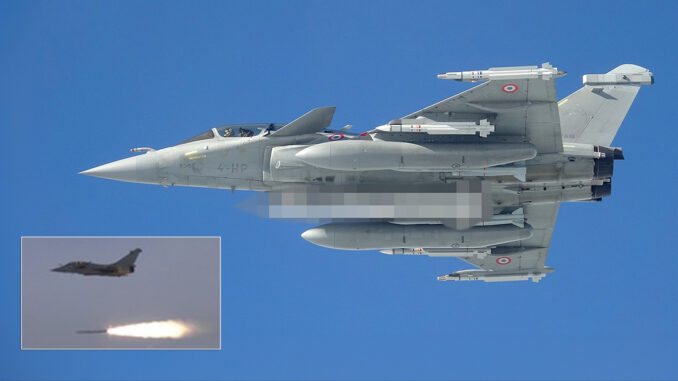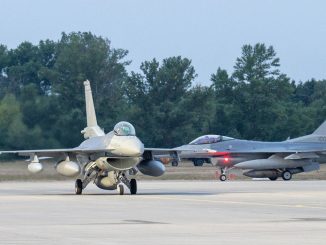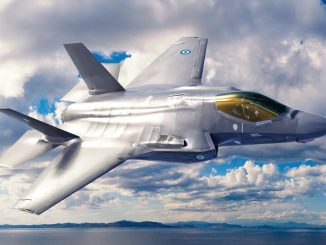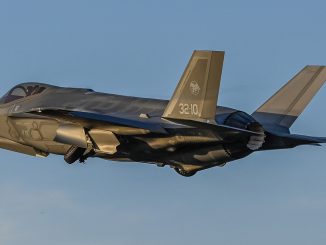
France steps up its nuclear deterrence, in the ever changing European security landscape with test of ASMA-R supersonic nuclear-capable missile.
French DGA agency (Directorate General of Armaments – French MoD’s procurement body) and Armed Forces Minister of France Sébastien Lecornu, announced on May 22, 2024, the first evaluation launch of the upgraded ASMP-A (alternatively: ASMPA-R, Air-Sol Moyenne Portée-Amélioré rénové) medium-range air-to-surface strategic missile. The missile, with an inert warhead, was launched by the French Strategic Air Forces (Forces Aériennes Stratégiques, a component of the French Aerospace Forces, Armée de l’Air et de l’Espace) Rafale B during a simulated nuclear air strike
The test, codenamed Durandal involved a launch of inert ASMPA-R, whose flight was tracked from the landes Biscarrosse missile range (DGA Essais de Missiles), and the DGA Hourtin and Quimper facilities. The test, alongside the main launch platform, also involved another two Rafale Bs, Mirage 2000-5F, and A330 Phénix MRTT.
The first notifications for this exercice appeared on April 25th. This proves that 🇫🇷 and 🇷🇺 ex. are not linked. Such event takes weeks or months to prepare.
The document shows the scenario, that included different phases at low to very low altitude, simulating a nuclear raid. pic.twitter.com/GHL8T3vved
— Etienne Marcuz (@M51_4ever) May 22, 2024
The ASMP missiles with TN81 150-300 kT yield nuclear warheads were originally commissioned in 1986. They first upgrade, the ASMP-A, was delivered in 2009. The further updated AMSPA-R variant was first test-launched on Dec. 9, 2020, and then fired again, a year later, in 2021, and also in March 2022. The missile offers an extended range of 600 kilometres and travels at Mach 3. The latest variant features a new generation TNA 300 kT thermonuclear warhead. It uses a ramjet propulsion.
Opération Durandal : un Rafale des Forces aériennes stratégiques vient de réaliser avec succès le premier tir d’essai en vol d’un missile nucléaire supersonique ASMPA rénové, sans charge embarquée.
Cette opération, prévue de longue date, concrétise l’ambition prévue en loi de… pic.twitter.com/DvEX3h62PV
— Sébastien Lecornu (@SebLecornu) May 22, 2024
Interestingly, the official images of the test released by the French MoD and French Air Force were blurred to hide all the details about the missile.
Aujourd’hui, l’@Armee_de_lair et les équipages des FAS ont réussi le premier tir d’évaluation des forces du missile ASMP-A rénové en coopération avec la @DGA. Une nouvelle démonstration de la crédibilité de la composante aéroportée de la dissuasion nucléaire. pic.twitter.com/HNWf7RvtkU
— Armée de l’Air et de l’Espace (@Armee_de_lair) May 22, 2024
French nuclear deterrence
The ASMP-A has been a cornerstone of the French nuclear deterrence posture since its introduction in October 2009, providing the user with a strategic strike capability, thanks to its seamless integration with the Rafales. The integration has been a complex task, since it involved avionics, targeting systems mods, and new elements of pilot training as well, all to allow the French Air Force to securely handle the nuclear payload and efficiently deter the potential adversaries. Rafale inherits the nuclear strike capacity in the French Air Force from the Super Entendards and Mirage 2000Ns.
France, as a prominent nuclear-armed nation, upholds a formidable and autonomous nuclear deterrence strategy known as the “Force de Frappe.” This comprehensive deterrent framework is meticulously designed to safeguard national security and maintain strategic autonomy. With an arsenal comprising approximately 290 nuclear warheads, subject to periodic maintenance and modernization, France executes its nuclear capabilities through two principal delivery platforms: Submarine-Launched Ballistic Missiles (SLBMs) and air-launched cruise missiles.
At the heart of France’s maritime nuclear capability lie its four Le Triomphant-class submarines: Le Triomphant, Le Téméraire, Le Vigilant, and Le Terrible. These submarines form the backbone of France’s SLBM capability, each armed with M51 SLBMs. The latest iteration, the M51.2, boasts an impressive range of approximately 10,000 kilometres and can deploy multiple independently targetable reentry vehicles (MIRVs), each carrying a potent nuclear payload.
In tandem with its maritime deterrent, France relies on air-launched cruise missiles to bolster its nuclear posture. Foremost among these is the Air-Sol Moyenne Portée-Amélioré (ASMP-A) missile, which ensures France’s ability to project nuclear power across strategic distances. Notably, squadrons like EC 3/4 at Istres and EC 1/91 at Saint Dizier stand ready to deploy the ASMP-A, underscoring France’s unwavering commitment to nuclear deterrence.
In essence, France’s nuclear deterrence scheme is a meticulously orchestrated fusion of maritime and aerial capabilities, underpinned by cutting-edge technology and operational proficiency. By maintaining a diverse array of delivery platforms and continuously enhancing its nuclear arsenal, France ensures that its “Force de Frappe” remains a potent and credible deterrent against potential adversaries, safeguarding the nation’s security and sovereignty.



